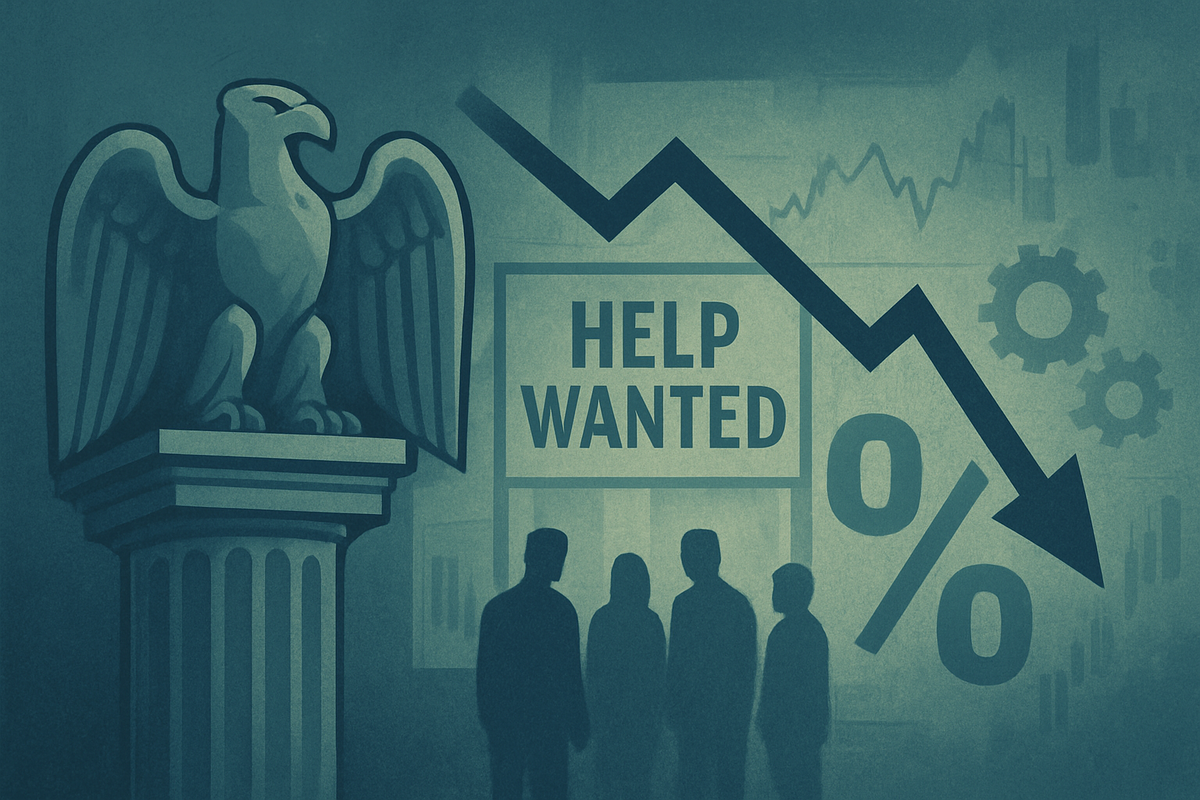
Washington D.C. – October 29, 2025 – In a move that underscores growing concerns about the nation's employment landscape, the Federal Reserve today announced its second consecutive interest rate cut, lowering the federal funds rate by another 25 basis points to a target range of 3.75%-4.00%. This decisive action, coming amidst a backdrop of a visibly "waning" job market and an ongoing government shutdown complicating economic data releases, signals a significant pivot in the central bank's strategy, prioritizing its maximum employment mandate even as inflation remains stubbornly above its 2% target.
The Fed's decision reflects a delicate balancing act, acknowledging a cooling labor market that threatens broader economic stability. While lower borrowing costs are intended to breathe life into stagnating hiring and prevent a surge in unemployment, the move also raises questions about the central bank's commitment to price stability. Investors and businesses are now grappling with the implications of cheaper credit on one hand, and the underlying economic weakness that necessitated the cuts on the other.
The Fed's Urgent Response to a Slowing Economy
Today's rate cut is the culmination of a year marked by increasingly worrying signs in the labor market. Throughout 2025, job gains have steadily decelerated, with monthly hiring figures slowing to an average of just 29,000 for the three months preceding October. The unemployment rate, while still historically low, has shown a noticeable upward creep, rising to 4.3% in August from 4.2% in July. Private sector indicators have further corroborated this trend, with Indeed's Job Postings Index declining by 3.5% in the two months leading up to mid-October, signaling a broader pullback in hiring intentions across industries.
Adding a layer of complexity to the Federal Open Market Committee's (FOMC) decision-making process is the ongoing federal government shutdown, which commenced on October 1st. This shutdown has created an "informational vacuum," halting the release of crucial official economic data, including the latest monthly jobs reports and consumer spending figures. Consequently, the Fed has been forced to rely heavily on available private sector data and anecdotal evidence, with Chair Jerome Powell acknowledging the "no risk-free path" for the central bank given the conflicting signals of a cooling labor market and persistent, albeit moderating, inflation, estimated around 3% annually in September. Today's cut follows an initial 25-basis-point reduction in September, bringing the federal funds rate from its previous range of 4.25%-4.50% down to the current 3.75%-4.00%.
Initial market reactions to the September cut saw the S&P 500 (SPX) reach new all-time highs, reflecting optimism that lower rates would stimulate growth. Following today's announcement, bond prices continued their appreciation, with short-term Treasury yields falling further, as they are closely tied to the federal funds rate. The U.S. dollar has shown a tendency to weaken against other major currencies, making dollar-denominated assets less attractive but potentially boosting U.S. exports. Conversely, gold prices have seen an uptick, benefiting from the reduced opportunity cost of holding non-interest-bearing assets. While borrowers can anticipate lower costs for mortgages, auto loans, and business credit, savers will likely face reduced returns on their deposits, highlighting the trade-offs inherent in the Fed's accommodative stance.
Market Movers: Who Wins and Who Loses?
The Federal Reserve's pivot to rate cuts in response to a weakening job market creates distinct winners and losers across the financial landscape. Companies with high growth potential and those carrying significant debt loads are often the primary beneficiaries of lower interest rates. Technology giants like Apple Inc. (NASDAQ: AAPL) and Microsoft Corp. (NASDAQ: MSFT), which often rely on future earnings growth to justify their valuations, tend to see their stock prices appreciate as the cost of capital decreases and investors become more willing to take on risk. Similarly, highly leveraged companies across various sectors will experience reduced interest expenses, bolstering their bottom lines.
The housing and real estate sectors are also poised for a potential boost. Lower mortgage rates could reignite buyer demand, benefiting homebuilders such as D.R. Horton Inc. (NYSE: DHI) and real estate investment trusts (REITs) focused on residential properties. Companies in the consumer discretionary sector, like Amazon.com Inc. (NASDAQ: AMZN) and Starbucks Corp. (NASDAQ: SBUX), might also see increased consumer spending if the rate cuts succeed in shoring up confidence and making borrowing more affordable for households. Conversely, the financial sector, particularly traditional banks, often faces headwinds during periods of falling interest rates. Banks like JPMorgan Chase & Co. (NYSE: JPM) and Bank of America Corp. (NYSE: BAC) typically experience a compression in their net interest margins (NIM) – the difference between what they earn on loans and what they pay on deposits – which can impact profitability. Companies that thrive in higher interest rate environments, such as certain insurance providers or money market funds, may also see their appeal diminish.
Wider Implications: Navigating a Shifting Economic Tide
This latest rate cut by the Federal Reserve is more than just a monetary policy adjustment; it's a significant indicator of broader shifts in the U.S. economy. The Fed's prioritization of employment over inflation, despite persistent price pressures, suggests a deep concern about the trajectory of the labor market and the potential for a more severe economic downturn. This move fits into a global trend where central banks are increasingly grappling with the dual challenges of slowing growth and elevated inflation, often referred to as "stagflationary" pressures. The ripple effects could extend to international markets, as a weaker dollar might make U.S. exports more competitive but could also impact global capital flows.
From a regulatory and policy perspective, the Fed's actions could put pressure on fiscal policy. If monetary policy alone proves insufficient to stimulate the economy, there might be renewed calls for government spending or tax cuts to support employment and growth. Historically, periods of rate cuts driven by a weakening job market have often preceded or accompanied economic slowdowns. For instance, the rate cuts in the early 2000s and during the 2008 financial crisis were responses to significant economic distress. While the current situation is not yet comparable in severity, the Fed's proactive stance highlights a cautious outlook. The ongoing government shutdown further complicates the picture, as the lack of comprehensive data makes it challenging for both policymakers and businesses to accurately assess the economic landscape, potentially leading to increased market volatility and investor uncertainty.
What Comes Next: A Path Forward Amidst Uncertainty
Looking ahead, the immediate future will be dominated by the market's interpretation of the Fed's commitment to its dual mandate. Short-term possibilities include continued market volatility as investors digest the implications of a weaker job market alongside cheaper credit. Businesses may need to strategically pivot, focusing on efficiency and cost management if the labor market weakness persists, while also exploring opportunities presented by lower borrowing costs for expansion or investment. The housing market, in particular, will be a key area to watch, as lower mortgage rates could either stabilize or significantly boost activity depending on broader consumer confidence and employment prospects.
In the long term, the effectiveness of these rate cuts in stimulating job growth without reigniting inflation will be crucial. Potential scenarios range from a "soft landing," where the economy avoids a recession and the job market gradually stabilizes, to a more challenging environment if inflation remains sticky and job losses accelerate. Market opportunities may emerge in sectors that can thrive in a lower-rate environment, such as technology and renewable energy, which often require significant capital investment. However, challenges will persist for sectors heavily reliant on robust consumer spending if unemployment rises. Investors should closely monitor upcoming economic data releases (once the government shutdown concludes), particularly employment figures, inflation reports, and consumer confidence surveys, for clearer signals on the economy's trajectory and the Fed's next steps.
Comprehensive Wrap-up: Navigating the New Economic Reality
Today's Federal Reserve interest rate cut, the second in as many months, marks a critical juncture for the U.S. economy. The central bank's decisive action, driven by a "waning" job market and complicated by an unprecedented government data blackout, underscores a clear shift in priority towards shoring up employment. Key takeaways include the Fed's willingness to act preemptively against labor market weakness, the immediate impact of lower borrowing costs on various sectors, and the inherent tension between supporting employment and managing persistent inflation.
Moving forward, the market will remain highly sensitive to any new economic indicators and future communications from the Federal Reserve. Investors should prepare for continued volatility and a nuanced market environment where traditional relationships between economic data and asset performance may be re-evaluated. The lasting impact of these rate cuts will depend on their ability to rejuvenate the job market without exacerbating inflationary pressures. What investors should watch for in the coming months are the resolution of the government shutdown and the subsequent release of official economic data, particularly the non-farm payroll reports and the Consumer Price Index. These will provide vital clarity on whether the Fed's gamble on employment will lead to a sustained recovery or a more prolonged period of economic uncertainty.
This content is intended for informational purposes only and is not financial advice






